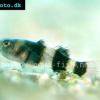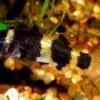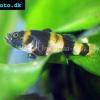Glass goby - Gobiopterus chuno
Scientific name: Gobiopterus chuno
Common name: Glass goby
Family: Gobiidae
Usual size in fish tanks: 2 - 3 cm (0.79 - 1.18 inch)
014
Recommended pH range: 6.5 - 7
Recommended water hardness: 4 - 12°N (71.43 - 214.29ppm)
0°C 32°F30°C 86°F
Recommended temperature range: 23 - 26 °C (73.4 - 78.8°F)
The way how these fish reproduce: Spawning
Where the species comes from: South Asia
Temperament to its own species: peaceful
Temperament toward other fish species: peaceful
Usual place in the tank: Bottom levels
Origin
The Glass Goby is native to waterways across Asia, primarily found in India, Bangladesh, Thailand, and Singapore. These fish typically inhabit slow-moving blackwater areas.
Short Description
Glass Gobies are not very common in the aquarium hobby and can be challenging to maintain long-term if not cared for properly. Their scientific name is Gobiopterus chuno, and they belong to the Gobiidae family. These fish are extremely peaceful and will coexist well with other similarly sized, non-aggressive species. They have a beautiful silver coloration with darker fins. The expected adult size for these fish is only 2 cm (~0.78 inch). Since most specimens are wild-caught, they may be a bit more expensive to purchase.
Lifespan
With proper care, the Glass Goby can live for 3 to 5 years. However, because these fish are typically wild-caught, it is difficult to determine their age when you acquire them.
General Care
Since Glass Gobies are usually wild-caught, it is crucial to ensure that the aquarium is fully cycled before introducing them. They should be housed only with fish that have similar water parameter needs and care requirements. A sandy substrate is recommended, with plants positioned along the sides and back of the aquarium to leave open swimming spaces. The water flow should be kept moderate, achieved by careful placement of the filter outlet nozzles.
Maintain a water temperature between 23-26°C (73-79°F) and keep the pH slightly acidic, ideally between 6.5 and 7.0. Regular water changes of at least 10% should be performed weekly, and the lighting should be kept at a moderate level.
Glass Gobies require live or frozen foods, as they may not accept commercial flake foods. It’s important to remember that these fish have small mouths, so the food offered should be appropriately sized. Newly hatched brine shrimp are ideal. Avoid overfeeding; small meals twice a day are better than one large meal to prevent uneaten food from decaying and affecting water quality.
Sexing
Females generally have a plumper body shape, particularly when they are ready to breed. This fuller appearance is due to the eggs they carry. However, sexing Glass Gobies can be quite challenging because these subtle differences are not always easy to spot, especially for those without experience. Observing their behavior during feeding or social interactions might offer additional clues, as females might exhibit different activity levels compared to males. Nevertheless, due to the difficulty in distinguishing between the sexes, it is recommended to leave sexing to experts or experienced aquarists.
Breeding
There are no recorded instances of breeding Glass Gobies in captivity. Very little is known about their breeding habits, other than that they are egg scatterers, which suggests they do not provide parental care.

 Candy
Candy  Goldenbanded
Goldenbanded  Golden
Golden  Bumblebee
Bumblebee  Atlantic
Atlantic  Goby
Goby